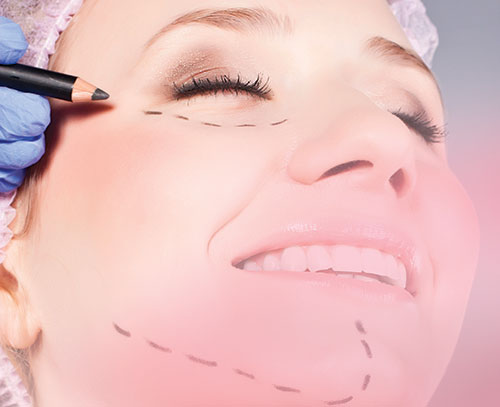Table of contents
This document has been conceived under the authority of the French Society of Plastic Reconstructive and Aesthetic surgery (Société Française de Chirurgie Plastique Reconstructrice et Esthétique – SOFCPRE) to complete the information that you received in your irst consultation with your Plastic Surgeon. It aims to answer all the questions that you might ask, if you decide to undertake blepharoplasty.
The aim of this document is to give you all the essential information you need in order to make an informed decision, with full knowledge of the facts related to this procedure. Consequently, we strongly advise you to read it carefully.

DEFINITION, AIMS AND PRINCIPLES
‘Blepharoplasties’ means aesthetic surgical procedures of the eyelids aiming to correct unsightly aspects, whether due to heredity or age. They can be performed on the upper or lower eyelids alone, or all four at the same time.
This technique may be carried out alone or in association with other cosmetic facial surgery (brow-lift, forehead-lift, face- and neck-lift) or with techniques such as laser resurfacing, dermabrasion or chemical peels. These procedures can be carried out during the same operation or in two stages.
The goal of a blepharoplasty is to correct signs of aging and remove the tired look due to the heavy eyelids by a more rested, relaxed appearance.
The unsightly aspects most commonly found are the following:
- Drooping heavy upper eyelids, with a more or less marked skin-fold.
- Lower eyelids which have drooped and shrunk, leading to horizontal wrinkles due to distended skin.
- Bulging fat, responsible for ‘bags under the eyes’ at the lower eyelid level, or sagging upper eyelids.
The procedure aims to correct these problems durably by surgical removal of excess skin, fat and muscle, without of course afecting the normal functions of the eyelids.
It should be noted that other age-related problems may be present but their treatment necessitates techniques more complex than standard blepharoplasty, or requires supplementary surgery.
These problems include sagging of the eyebrows, forehead wrinkles, frown lines, crow’s feet at the corners of the eyes, dark rings under the eyes, ‘hollow’ eyes, ‘sad’ eyes with down-turned corners, and also skin blemishes and minor scars.
This procedure, for both men and women, is often carried out around the age of forty.
It can however be done much earlier where the problem is congenital rather than age-related, for example in the case of bags under the eyes.
BEFORE THE OPERATION
Prior to the operation a thorough examination of the eyes and eyelids will have been carried out in order to detect any anomalies which could complicate the procedure or indeed show that it is not recommended in this specific case.
A specialised ophthalmologic examination will often be prescribed to rule out any ocular pathology.
A preoperative check up will be carried out as prescribed.
An anesthesiologist will see you in consultation at the latest 48 hours before the operation.
No aspirin-based medication should be taken during the 10 days preceding the operation.
For certain types of anesthesia you may be required to fast (neither eat nor drink) for six hours before the operation.
HOSPITAL STAY AND TYPE OF ANESTHESIA
Type of anesthesia
Three possibilities exist :
- Local anesthesia alone, in this case the eyelids are numbed by an injection given locally.
- Local anesthesia with sedation given by intravenous drip (‘twilight’ anesthesia).
- Standard general anesthesia, you sleep throughout the procedure
The type of anesthesia will be chosen after discussion between yourself, the surgeon and the anesthesiologist.
Hospital stay
The procedure may be carried out on an out-patient basis, in an ambulatory facility, the patient leaves on the same day after a few hours under observation.
However, in some cases a short hospital stay can be preferable. The patient arrives in the morning (or sometimes the previous evening) and is discharged the following morning.
THE PROCEDURE
Each surgeon has adopted his or her own specific technique which he or she adapts in order to obtain the best results in each case.

We can however give some basic points.
Incisions
- Upper eyelids: They are concealed in the fold situated at the mid-point of the eyelid, between the mobile and fixed parts.
- Lower eyelids: They are 1 to 2mm below the eyelashes, and can go slightly beyond them.
The line of these incisions corresponds of course to the position of the scars, which will therefore be hidden in folds of skin.
Note: For the lower eyelids, in the case of isolated “bags” (without excess skin to be removed), a blepharoplasty can be carried out by the transconjunctival approach, that is by using incisions placed inside the eyelids, thus leaving no visible scars.
Resection:
Once the incision made, unsightly excess fat is removed, as are redundant muscle and sagging skin. At this stage, numerous appropriate adjustments can be made in order to tailor the procedure to the specific needs of the patient.
Sutures:
Stitches are made using very ine nonabsorbable thread (they are removed a few days after the procedure).
The operation can take between 30 minutes and 2 hours depending on the specific requirements and complexity of the case.
AFTER THE OPERATION
There is no actual pain, but possibly some discomfort with a sensation of tension in the eyelids, slight irritation of the eyes and perhaps some blurring of vision.
During the first few days rest is advised, with no physical strain, no lifting heavy weights for example.
During the recovery period there will be edema (swelling), and bruising, to a variable degree for each individual patient.
For the first few days it may be impossible to close the eyes completely, a slight detachment of the external angle of the eye may also be observed, but in both cases these signs are rapidly reversible.
The sutures will be removed between the 3rd and 6th day after surgery.
Visible signs of the operation will diminish little by little, a return to normal social and professional activities will be possible after 6 to 20 days.
The scars may remain as pinkish lines for the first few weeks, but can be hidden by makeup from the 7th day onward.

Slight hardening of the detached zones may persist for a few months, but is not perceptible to others.
THE RESULT
The final aspect will not be visible before 3 to 6 months. This is the time lapse necessary for the tissues to regain their softness and for the scars to heal and practically disappear.
In general the procedure will have corrected redundant skin folds and removed fatty pads thus rectifying the old, tired look.
The results of this procedure are usually among the most durable found in aesthetic surgery. Once the fatty pads removed they do not in general return, so this is a permanent effect. On the other hand skin does continue to age and the excess folds of the eyelids can, over time, recur. However a second operation is rarely envisaged within twelve years.

DISAPPOINTING RESULTS
These can result from a misunderstanding concerning what can reasonably be achieved. For example lowering of the forehead and eyebrows can only be corrected by a forehead and brow-lift.
They can also be due to unexpected tissue reaction or unusual scarring phenomena.
Very fine lines may persist, the eyes may appear slightly too ‘hollow’ (the bony outline of the eye-socket being visible).
Other imperfect results could be a slight downward retraction of the lower eyelids, slight asymmetry, or ‘whitish’ scars.
These imperfections can be remedied by corrective surgery if necessary, usually under local anesthesia from the 6th month following surgery.
POSSIBLE COMPLICATIONS
A blepharoplasty, although essentially an aesthetic procedure, is nevertheless an operation, and this implies that the risks inherent to any surgery apply here.
We must distinguish here between risks related to the anesthesia and those related to the surgery.
⚫ For the anesthesia, the risks will be explained by the anesthesiologist during the preoperative consultation. You must be aware that anesthesia can cause unpredictable reactions, which can be difcult to control: the presence of an experienced anesthesiologist, in a surgical context, means that the risks are statistically practically negligible.
In fact techniques, products and monitoring methods have progressed considerably over the last twenty years, giving optimal safety, especially when the operation is not an emergency and the patient is in good general health.
⚫ Concerning surgery: by choosing a competent, qualified Plastic Surgeon, used to performing this procedure, you limit the risks, without however eliminating them completely.
Fortunately, real complications are rare following a blepharoplasty which has been carried out correctly. In fact practically all the operations go well and patients are completely satisied with the result.
In spite of the fact that complications are so rare you must be aware of the following possible problems:
- Hematomas: not usually serious, they can be drained if necessary.
- Infections: extremely rare for this procedure, micro abscesses can develop on stitches but are easily treated. Conjunctivitis will be prevented by routine prescription of eye-drops for the first few days after the procedure.
- Abnormal scarring: this is very rare for the eyelids where the skin usually heals leaving almost no trace of surgery, the scars can however sometimes be more pronounced than hoped.
- Epidermal cysts: they can appear along the scars, but often clear spontaneously, if not they can easily be removed and do not afect the final result.
- Lacrymal problems: excessive tear production is a rarer problem than ‘dry eye syndrome’ which can decompensate a pre-existing lack of tear production.
- Ptosis (Drooping of the upper eyelid): this is very rare except in the over 70’s where a pre-existing problem can be made worse by the operation
- Lagophthalmos (inability to close the upper eyelid completely): this can occur for the first few days after surgery but should not persist after a few weeks.
- Ectropion (lower eyelid retraction): the severe form is extremely rare following this procedure when it is carried out correctly. The minor form can occur when lax tissue is affected by excessive scar retraction; it usually recedes after several weeks of regular massage which improves the tonus of the eyelids.
- Finally, extremely rare cases of diplopia (double vision), glaucoma, and even blindness following blepharoplasty have been described in International Medical Journals.
All things considered, the risks must not be overestimated, but you must be conscious that an operation, even a minor one, always has some degree of unforeseeable unknown factors.
You can be assured that if you are operated on by a qualiied Plastic Surgeon, he will have the experience and skill required to avoid these complications, or to treat them successfully if necessary.

